
Bible translations into Sorbian have a long history with the oldest translation published in 1547.

Bible translations into Sorbian have a long history with the oldest translation published in 1547.
The oldest Sorbian Bible version, that of the New Testament of 1547, is extant in a manuscript in the Royal Library at Berlin. The translator was Miklawš Jakubica, [1] who employed a now-extinct dialect of Lower Sorbian. [2] In the 18th century de:Johann Gottlieb Fabricius (dsb:Jan Bogumił Fabricius), a German, made a translation of the New Testament which was printed in 1709. In a revised form this version was published by the British and Foreign Bible Society in 1860. The Old Testament, translated by J. F. Fritz, was printed at Cottbus in 1796. [3] An edition of the entire Bible was published by the Prussian Bible Society in 1868.
Michał Frencel [4] Pastor in Postwitz (Sorbian Budestecy)(d. 1706), translated the New Testament into the Upper Sorbian, and his version was published by his son, Abraham Frencel (Zittau, 1706). A complete edition of the Bible, the work of different scholars, was first published at Bautzen, 1728. A second revised edition was prepared by Johann Gottfried Kühn and issued in 1742; a third improved edition prepared by Johann Jacob Petschke was published in 1797. Passing over other editions, the ninth edition of the complete Bible (Bautzen, 1881) was revised by H. Immisch and others and also contains a history of the Upper Lusatian Wendish Bible translation. G. Lusanski and M. Hornik translated the New Testament from the Vulgate for the Roman Catholic Wends of Upper Lusatia and published it at Bautzen, 1887–92; the Psalms were translated from the Hebrew by J. Laras (Bautzen, 1872).

Christian Friedrich Henrici, writing under the pen name Picander, was a German poet and librettist for many of the cantatas which Johann Sebastian Bach composed in Leipzig.

Reinhard Keiser was a German opera composer based in Hamburg. He wrote over a hundred operas. Johann Adolf Scheibe considered him an equal to Johann Kuhnau, George Frideric Handel and Georg Philipp Telemann, but his work was largely forgotten for many decades.
Dietrich Nikolaus Winkel was the inventor of the first successful metronome. He also invented the componium, an "automatic instrument" that could make endless variations on a musical theme.
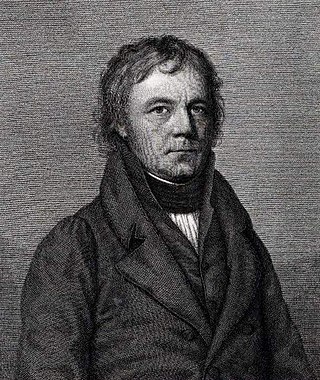
Johann Heinrich van Ess, was a German Catholic theologian, born at Warburg, Westphalia.
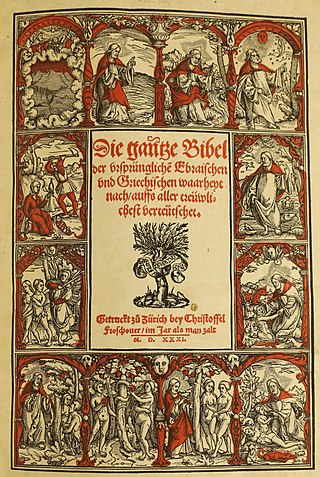
The Zürich Bible is a Bible translation historically based on the translation by Huldrych Zwingli. Recent editions have the stated aim of maximal philological exactitude.
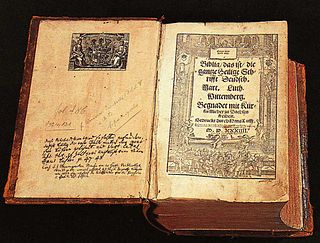
The Luther Bible is a German language Bible translation by the Protestant reformer Martin Luther. A New Testament translation by Luther was first published in September 1522, and the completed Bible, containing a translation of the Old and New Testaments with Apocrypha, in 1534. Luther continued to make improvements to the text until 1545. It was the first full translation of the Bible into German that used not only the Latin Vulgate but also the Greek.

The Spaceships of Ezekiel (1974) is a book by German engineer Josef F. Blumrich about a spaceship that was supposedly observed by the prophet Ezekiel as described in Book of Ezekiel in the Tanakh. Blumrich wrote it while chief of NASA's systems layout branch of the program development office at the Marshall Space Flight Center. It was originally published in German by Econ Verlag GmbH under the title Da tat sich der Himmel auf .. Because it refers to theories and speculations about ancient astronauts, it is considered to be a work of pseudoscience as well as being an example of euhemerism.
German language translations of the Bible have existed since the Middle Ages. The most influential is Luther's translation, which established High German as the literary language throughout Germany by the middle of the seventeenth century and which still continues to be most widely used in the German-speaking world today.

Kurt Aland was a German theologian and biblical scholar who specialized in New Testament textual criticism. He founded the Institut für neutestamentliche Textforschung in Münster and served as its first director from 1959 to 1983. He was one of the principal editors of Nestle–Aland – Novum Testamentum Graece for the Deutsche Bibelgesellschaft and The Greek New Testament for the United Bible Societies.
Johann Gottfried Schnabel was a German writer best known for his novel Insel Felsenburg. He published his works under the pen name Gisander.
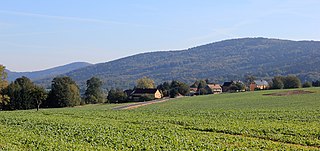
Czorneboh is a mountain between Hochkirch and Cunewalde in Upper Lusatia. Czorneboh is located 10 km. from the German-Czech border north of Šluknov and 8 km. southeast of Bautzen and with an altitude of 555.7 m it is the highest point of this foothill of the Lusatian Highlands. The peak of the Czorneboh is located in the district of Meschwitz. On the top there is a mountain hostel and an observation tower.
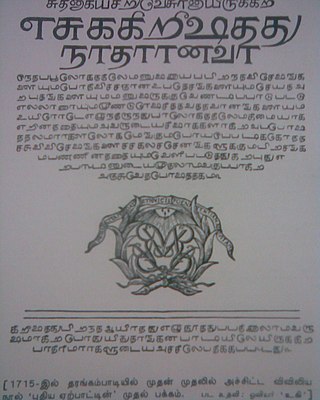
The history of Bible translations into the Tamil language commences with the arrival of Bartholomäus Ziegenbalg at Tranquebar in 1706.Johann Philipp Fabricius, a German, revised Ziegenbalg's and others work to produce the standard Tamil version. Seventy years after Fabricius, at the invitation of Peter Percival a Saiva scholar, Arumuka Navalar, produced a "tentative" translation, which is known as the "Navalar version," and was largely rejected by Tamil Protestants.
The Hacker Bible is a publication of the German hacker organization Chaos Computer Club (CCC). It has been published in two editions to date, 1985 and 1988. Both were edited by Wau Holland and published on the Grüne Kraft press.
The Deutsche Theatrum Chemicum is a collection of alchemical texts, predominantly in German translation, which was published in Nuremberg in three volumes by Friedrich Roth-Scholtz (1687–1736), the publisher, printer and bibliographer.
Picander's cycle of 1728–29 is a cycle of church cantata librettos covering the liturgical year. It was published for the first time in 1728 as Cantaten auf die Sonn- und Fest-Tage durch das gantze Jahr. Johann Sebastian Bach set several of these librettos to music, but it is unknown whether he covered a substantial part of the cycle. This elusive cycle of cantata settings is indicated as the composer's fourth Leipzig cycle, or the Picander cycle.

On Trinity Sunday 27 May 1725 Johann Sebastian Bach had presented the last cantata of his second cantata cycle, the cycle which coincided with his second year in Leipzig. As director musices of the principal churches in Leipzig he presented a variety of cantatas over the next three years. New cantatas for occasions of the liturgical year composed in this period, except for a few in the chorale cantata format, are known as Bach's third cantata cycle. His next cycle of church cantatas, the Picander cycle, did not start before St. John's Day 24 June 1728.
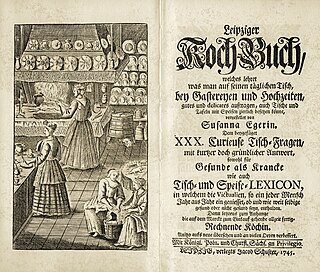
Susanna Eger, also Egerin, née Born (1640–1713) was a German cook and cookbook writer. She is remembered for her pioneering Leipziger Kochbuch, first published in 1706. It was later translated into Swedish as En nödig och nyttig hushålds och kokbok (1733), becoming one of Sweden's earliest cookbooks.
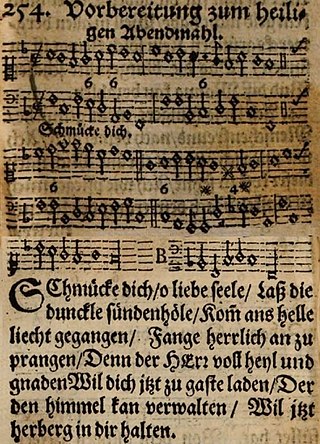
"Schmücke dich, o liebe Seele" is a Lutheran hymn in German, with lyrics by Johann Franck and a hymn tune by Johann Crüger. It was first published in Crüger's 1649 Geistliche Kirchen-Melodien, and was later adopted in other hymnals, such as the 1653 edition of his Praxis pietatis melica.

"Macht hoch die Tür" is a popular German Advent hymn, written in 17th century Ducal Prussia. The lyrics were written by Georg Weissel in 1623 for the inauguration of the Altroßgärter Kirche in Königsberg. The melody that is now associated with the text appeared first in 1704 in the hymnal by Johann Anastasius Freylinghausen.
"Nun liebe Seel, nun ist es Zeit", alternatively written "Nun, liebe Seel, nun ist es Zeit", is a Lutheran hymn for Epiphany, in five stanzas of six lines each, by Georg Weissel. It was first printed in 1642, set as a motet by Johannes Eccard. A version with an additional stanza is attributed to Johann Christoph Arnschwanger.